List of monastic houses in Kent facts for kids
A monastic house is a special place where groups of people, like monks or nuns, lived together under religious rules. They dedicated their lives to prayer, study, and work. These places were very important in history, acting as centers for learning, charity, and farming. In Kent, a county in England, there were many such houses, each with its own story.
Alien houses are included, as are smaller establishments such as cells and notable monastic granges (particularly those with resident monks), and also camerae of the military orders of monks (Knights Templars and Knights Hospitaller). Monastic hospitals are included where they had the status or function of an abbey, priory, friary or preceptor/commandery.
- Abbreviations and key
| Symbol | Status |
|---|---|
| None | Ruins |
| * | Current monastic function |
| + | Current non-monastic ecclesiastic function (including remains incorporated into later structure) |
| ^ | Current non-ecclesiastic function (including remains incorporated into later structure) or redundant intact structure |
| $ | Remains limited to earthworks etc. |
| # | No identifiable trace of the monastic foundation remains |
| ~ | Exact site of monastic foundation unknown |
| ≈ | Identification ambiguous or confused |
Locations with names in italics indicate possible duplication (misidentification with another location) or non-existent foundations (either erroneous reference or proposed foundation never implemented) or ecclesiastical establishments with a monastic name but lacking actual monastic connection.
| EH | English Heritage |
| LT | Landmark Trust |
| NT | National Trust |
Monastic Houses in Kent
This table lists many of the monastic houses that once existed in Kent. You'll find out what kind of religious community lived there, when they were founded, and what happened to them.
| Name | Image | Who Lived There & Their Story | Other Names | Location |
|---|---|---|---|---|
| Aylesford Priory | 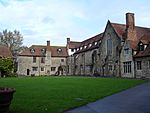 |
Carmelite Friars (a type of monk) started this priory in 1242. The church was built between 1242 and 1248. It was rebuilt later, from 1348 to 1417. The priory closed in 1538. The church was taken down, and the other buildings became a private home. After a fire in 1930, it was rebuilt. Carmelite Friars returned in 1949 and still live there today. | The Friars | 51°18′11″N 0°28′19″E / 51.3030815°N 0.4720098°E |
| Badlesmere Priory | Augustinian Canons Regular (another type of monk) founded this house in the 8th century. | |||
| Badmonden Priory | Augustinian Canons Regular lived here. It was a small house that belonged to Beaulieu Abbey in Normandy, France. It closed in 1414 and was given to St Andrew's Priory, Rochester. It closed again in 1540 and was given to the Rochester Cathedral. | |||
| Bilsington Priory | 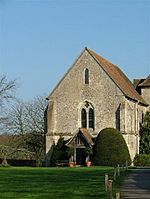 |
Augustinian Canons Regular founded this priory in 1253. It was started by John Mansell, who was a very important judge. The priory closed on February 28, 1536. It was then given to the Archbishop of Canterbury. Today, its old buildings are part of a farmhouse. | 51°04′57″N 0°54′57″E / 51.0826112°N 0.9159355°E | |
| Blakwose Priory | Premonstratensian Canons (a religious order) founded this house before 1158. It was a small part of Lavendon Abbey in Buckinghamshire. After 1203, it was moved to St Radegund's Abbey and became a farm for them. It closed around 1377. | Blackwose Priory | 51°04′27″N 1°04′04″E / 51.074034°N 1.0677485°E | |
| Boxley Abbey | 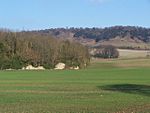 |
Cistercian monks (a strict order of monks) founded this abbey on October 23, 1143. It was a "daughter house" of Clairvaux Abbey in France. William de Ipre, the Earl of Kent, started it. The abbey closed on January 21, 1538. Its remains are now part of a private house. | The Priory Church of the Blessed Virgin Mary, Bilsington | 51°18′00″N 0°31′29″E / 51.3000261°N 0.5246937°E |
| Canterbury Austin Friars, earlier site | Augustinian Friars started here in 1318. They moved to a new site in 1324. | 51°16′37″N 1°04′54″E / 51.276936°N 1.081654°E | ||
| Canterbury Austin Friars | The Augustinian Friars moved to this site in 1324. Their buildings were rebuilt in 1408. The friary closed in December 1538. | 51°16′37″N 1°04′54″E / 51.276936°N 1.0816544°E | ||
| Canterbury Blackfriars | 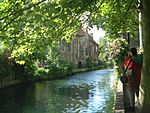 |
Dominican Friars (also known as Blackfriars) started here around 1236, founded by King Henry III. Their church was built from 1237 onwards. The friary closed in 1538. Today, part of the old building is used as a church. | 51°16′53″N 1°04′45″E / 51.2813435°N 1.0792083°E | |
| Canterbury Cathedral Priory | 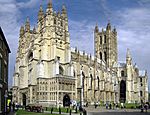 |
This site was first a Roman church, restored around 600 by St Augustine and King Æthelberht. It became a cathedral. Benedictine monks lived here from 997. The cathedral was rebuilt in 1070. The priory closed in 1539, but the cathedral is still active today. | The Cathedral and Abbey Church of Christ, Canterbury | 51°16′47″N 1°04′59″E / 51.279689°N 1.083183°E |
| Canterbury Friars of the Sack | The Friars of the Sack (a smaller religious order) were founded before 1274. They closed after 1314. | 51°16′50″N 1°04′39″E / 51.2804644°N 1.0776365°E | ||
| Canterbury Greyfriars | 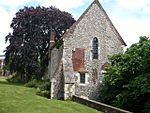 |
Franciscan Friars Minor (also known as Greyfriars) first started in Canterbury in 1224. They moved to this site around 1268. The friary closed in 1538. | 51°16′44″N 1°04′36″E / 51.2788839°N 1.0767943°E | |
| Canterbury — St Augustine's Abbey | 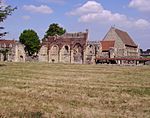 |
Benedictine monks started this abbey around 598, with help from King Æthelberht and St Augustine. It was refounded around 960. The abbey closed on July 30, 1538. Today, it's a historic ruin managed by English Heritage. | St Peter and St Paul | 51°16′41″N 1°05′17″E / 51.278126°N 1.088156°E |
| Canterbury — St Gregory's Priory | This was a religious community founded by Archbishop Lanfranc before 1086. It was refounded for Augustinian Canons Regular around 1123. The church burned down in 1145 but was rebuilt. The priory closed in 1536. | St Gregory's Hospital | 51°16′58″N 1°05′04″E / 51.2827159°N 1.0843608°E | |
| Canterbury — Priory of St Sepulchre | Benedictine nuns founded this priory around 1100, started by Archbishop Anselm. It closed in 1536. | St Sepulchre's Nunnery | 51°16′26″N 1°05′05″E / 51.2739107°N 1.0846424°E | |
| Canterbury — St Mary of the Angels Friary | Franciscan Friars Minor run this friary, which is involved with the Franciscan International Study Centre. It is still active today. | Friary of St Mary of the Angels | 51°17′45″N 1°03′42″E / 51.2957075°N 1.0615915°E | |
| Combwell Priory | Augustinian Canons Regular founded this abbey around 1220. It became a priory because it didn't have enough money. It closed in 1536. | Cumbwell Priory | 51°04′26″N 0°26′02″E / 51.0738537°N 0.4338795°E | |
| Darenth Priory | Benedictine monks lived here. It was a small part of Rochester Cathedral. It was founded after 971. We don't know when it closed. | 51°25′00″N 0°14′31″E / 51.4165689°N 0.2420104°E | ||
| Dartford Blackfriars | Dominican Friars started here in 1356, connected to the nunnery nearby. It closed in 1539. | |||
| Dartford Priory |  |
Dominican nuns founded this priory in 1346, started by King Edward III. It closed after 1539. King Henry VIII built a manor house on the site. Dominican nuns returned briefly in 1558 but it closed again after 1559. | St Mary and St Margaret | 51°26′58″N 0°12′53″E / 51.4494672°N 0.2148342°E |
| Davington Priory | 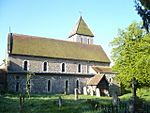 |
Benedictine nuns founded this priory in 1153. It closed in 1535. The church is still used today, and the priory buildings are now a private home. | The Priory Church of Saint Mary Magdalen, Davington | 51°19′09″N 0°53′03″E / 51.3191235°N 0.8842975°E |
| Dover Priory, earlier site | 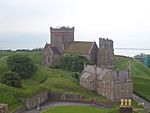 |
This was a Saxon minster (an early monastery) with secular canons (priests who lived in a community but weren't monks). It was founded in 640. The church was rebuilt in the 10th century. It fell into ruins but was restored in the 1800s. | St Mary in Castro | 51°07′42″N 1°19′24″E / 51.128374°N 1.3233697°E |
| Dover Priory | This priory was first for secular canons around 696. It was refounded for Augustinian Canons Regular in 1131. Later, Benedictine monks from Canterbury took over. It closed in 1535. The remains are now part of Dover College, a private school. | The Priory Church of Saint Mary the Virgin and Saint Martin | 51°07′37″N 1°18′27″E / 51.1270341°N 1.3075729°E | |
| Dover Minster | This was a Saxon minster founded in 691. It was rebuilt in the 1070s. It was used as a parish church but was later demolished. | 51°07′30″N 1°18′45″E / 51.1250006°N 1.3125336°E | ||
| Dover Preceptory (?) | This was a house for the Knights Templar (a military religious order) founded around 1128. It seems to have moved to Temple Ewell before 1185. | 51°07′09″N 1°18′12″E / 51.1190578°N 1.3034517°E | ||
| Faversham Abbey |  |
Cluniac monks (another Benedictine order) founded this abbey in 1148, started by King Stephen and Queen Maud. It became a Benedictine monks abbey by the 13th century. It closed on July 8, 1538. | St Saviour | 51°19′08″N 0°53′42″E / 51.318774°N 0.8948708°E |
| Folkestone Priory, earlier site | This was a Saxon minster and possibly for Benedictine nuns, founded before 640. It was destroyed by Danish raids before 927. Later, Benedictine monks from Lonlay, France, started a house here in 1095. They moved to a new site in 1137. | St Mary and St Eanswith | 51°04′45″N 1°11′01″E / 51.0790314°N 1.1837474°E | |
| Folkestone Priory | Benedictine monks moved here in 1137 from their earlier site. They were originally connected to Lonlay Abbey in France but became independent in 1399. The priory closed in November 1539 because it was in ruins. | Falkstone Priory | 51°04′43″N 1°10′53″E / 51.0786935°N 1.1813951°E | |
| Higham Priory | Benedictine nuns founded this priory around 1148, started by King Stephen. They were connected to St-Sulpice-la-Forêt in France but became independent after 1227. The priory closed in 1521-22. | Lillechurch Priory | 51°26′27″N 0°28′11″E / 51.4408812°N 0.4697406°E | |
| Hoo Monastery | This monastery for Benedictine monks was founded around 686-687. It was likely destroyed by Danish raids in the 9th century. | 51°27′24″N 0°29′19″E / 51.4565357°N 0.4886945°E (possible) or 51°24′36″N 0°33′29″E / 51.410135°N 0.558055°E (more likely) |
||
| Horton Priory | 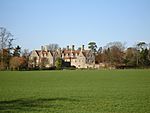 |
Cluniac monks (another Benedictine order) founded this priory around 1142. It was a small part of Lewes Priory in Sussex but became independent later. It closed in 1536. Its remains are now part of a private house. | The Priory Church of St John the Evangelist, Horton | 51°06′52″N 1°00′28″E / 51.1143114°N 1.0078186°E |
| Leeds Priory | Augustinian Canons Regular founded this priory in 1119. It closed around 1540. | St Mary and St Nicholas | 51°14′51″N 0°36′42″E / 51.2474614°N 0.611659°E | |
| Lossenham Friary | Carmelite Friars founded this friary around 1242-1247. It was destroyed by fire in 1275 but rebuilt. It closed in 1538. | Lossenham Whitefriars | 51°01′12″N 0°37′27″E / 51.0199877°N 0.6241071°E | |
| Lydd Monastery | This was a Saxon minster, possibly a monastery, founded after 774. It was destroyed by Danish raids in 893. Parts of the old monastery are now in the All Saints' parish church. | 50°57′06″N 0°54′25″E / 50.9517832°N 0.90693°E | ||
| Lyminge Abbey | This abbey was for Benedictine nuns and was founded around 633. It was later refounded for monks and nuns before 736. It was attacked by Danes but continued until after 964. | Liming Abbey | 51°07′35″N 1°05′13″E / 51.1262732°N 1.0869813°E | |
| Maidstone Friary | Carmelite Friars bought Allington Castle in 1951. It is now privately owned. | 51°17′36″N 0°30′41″E / 51.2934382°N 0.5114543°E | ||
| Minster in Sheppey Priory | This priory was for Benedictine nuns and was founded around 670. It was destroyed by Danish raids before 900. It was refounded several times, including for Augustinian Canonesses. It closed in 1536. Parts of the old church are now in the local parish church. | St Sexburga | 51°25′20″N 0°48′43″E / 51.422169°N 0.812071°E | |
| Minster in Thanet Priory, earlier site | This Saxon minster for Benedictine nuns was founded in 669. It was destroyed by Danish raids in 1011. | St Domneva | 51°19′49″N 1°18′56″E / 51.3303703°N 1.3156772°E (purported) | |
| Minster in Thanet Priory | Benedictine nuns moved to this site from the earlier one. | St Mary Virgin | 51°19′53″N 1°19′03″E / 51.331287°N 1.3175547°E | |
| Minster Abbey | Benedictine nuns founded this abbey in 1937 on the site of the older abbey. It is still active today. | |||
| Moatenden Priory | Trinitarian monks founded this priory in 1224. It closed in 1538. The site is now a house called 'Moatenden Manor'. | Mottenden Priory | 51°11′16″N 0°36′05″E / 51.1878755°N 0.601421°E | |
| New Romney Priory | This was a "double house" for Cistercian monks and nuns, founded in 1264. It was a farm belonging to Pontigny Abbey in France. It closed around 1414. | St John | 50°59′09″N 0°56′23″E / 50.9859411°N 0.9397951°E | |
| New Romney Greyfriars | Franciscan Friars Minor founded this friary before 1241. It closed around 1287. | Romney Greyfriars | 50°58′43″N 0°56′00″E / 50.9785373°N 0.9332371°E | |
| Newington Priory | This priory was for Benedictine nuns. Its founding date is unknown. It may have become a college for secular canons before 1179. | 51°20′42″N 0°39′18″E / 51.3449619°N 0.6549847°E (alleged) or 51°05′27″N 1°06′42″E / 51.0908601°N 1.1117005°E (possible) | ||
| Patrixbourne Priory | 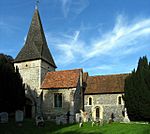 |
This was a Saxon minster. Later, Augustinian Canons Regular founded a priory here around 1200. It was connected to Beaulieu in Normandy, France. It closed in 1409. The church is still used today as the Parish Church of St Mary. | St Mary | 51°15′12″N 1°08′11″E / 51.2534448°N 1.1364627°E |
| Reculver Abbey | 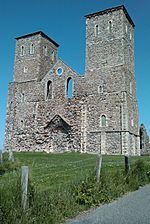 |
Benedictine monks founded this abbey in 669. It was attacked by Danes. It was later joined to Canterbury in 949. | Raculfe Abbey | 51°22′46″N 1°11′59″E / 51.3795322°N 1.1997628°E |
| Rochester Cathedral Priory | This site was first for secular canons in 604. It became a cathedral and is still active today. Benedictine monks refounded the priory in 1080. It closed in 1540. | The Cathedral and Priory Church of Saint Andrew, Rochester | 51°23′20″N 0°30′12″E / 51.3889331°N 0.5032146°E | |
| St Radegund's Abbey | Premonstratensian Canons founded this abbey in 1193. It closed in 1536. It is now privately owned. | Bradsole Abbey | 51°07′55″N 1°15′03″E / 51.1318449°N 1.2507623°E | |
| Sandwich Whitefriars | Carmelite Friars founded this friary before 1268. It closed in 1538. | 51°16′24″N 1°20′18″E / 51.2733301°N 1.3384169°E | ||
| Shoreham Minster | This was a Saxon minster founded before 700. The current church on the site was built between 1230 and 1270. | 51°19′59″N 0°11′04″E / 51.3330517°N 0.1844019°E | ||
| Sutton-at-Hone Preceptory | This was a hospital founded before 1199. It was given to the Knights Hospitaller (another military religious order) in 1214, who set up a preceptory (a type of commandery). It closed in 1358. The remains are now a chapel and private home. | St John's Jerusalem | 51°24′39″N 0°14′25″E / 51.4108076°N 0.2403098°E | |
| Swingfield Preceptory | This was a house for the Knights Hospitaller founded before 1180. It closed in 1540. | St John's Commandery | 51°09′07″N 1°11′26″E / 51.151887°N 1.1904824°E | |
| Temple Ewell Preceptory | 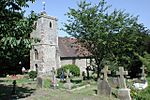 |
Knights Templar founded this preceptory around 1185. It closed between 1308 and 1312. Knights Hospitaller refounded it in 1312. It closed in 1540. Its remains are now part of the local parish church. | 51°09′52″N 1°16′04″E / 51.164581°N 1.2677246°E | |
| Thanington Nunnery | This was St James's hospital, founded before 1164. It seems to have become a nunnery before 1343. It closed in 1551. | Tanington Hospital | 51°15′48″N 1°03′06″E / 51.2633583°N 1.0516995°E | |
| Throwley Priory | Benedictine monks founded this priory around 1150. It was a small part of St Bertin Abbey in France. It closed in 1414. A house called 'Glebe Cottage' is now on the site. | Thurleigh Priory | 51°16′00″N 0°51′23″E / 51.2667384°N 0.8563542°E | |
| Tonbridge Priory | Augustinian Canons Regular founded this priory before 1192. It closed on February 8, 1525. The site later became a railway goods station. | St Mary Magdalen | 51°11′28″N 0°16′24″E / 51.1911183°N 0.2733278°E | |
| West Langdon Abbey | Premonstratensian Canons founded this abbey in 1189. It closed in 1535. The site is now a 16th-century farmhouse used as a holiday cottage. | St Mary and St Thomas Martyr of Canterbury | 51°10′28″N 1°19′36″E / 51.1745237°N 1.3266903°E | |
| West Malling Abbey | 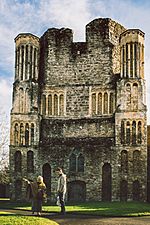 |
Benedictine nuns founded this abbey around 1090. It closed in 1538. | The Abbey Church of Saint Mary, West Malling | 51°17′36″N 0°24′45″E / 51.2932051°N 0.4124084°E |
| West Peckham Preceptory | Knights Hospitaller founded this preceptory in 1337. It closed in 1540. | West Peccham Hospital | 51°14′58″N 0°21′37″E / 51.2494727°N 0.360269°E |
See also

